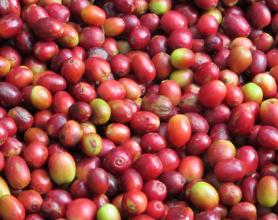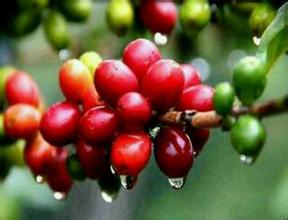How do coffee beans grow?-introduction to why coffee beans are roasted.
How coffee beans grow-why coffee beans are roasted
Robasta coffee trees are native to Madagascar in central and western Africa and Indonesia in Asia, and their production accounts for about 20% to 30% of the world's production. Robasta coffee tree is suitable for planting in lowlands below 500 meters above sea level. It has strong adaptability to the environment. It can resist harsh climate, resist pests and diseases. It does not need too much artificial care when preparing soil, weeding and pruning. It can grow freely in the wild. It is an easy to cultivate coffee tree. However, the finished product tastes bitter than Arabica, the caffeine content is also relatively high, and the quality is also inferior, so most of them are used to make instant coffee. Because it is mainly grown in Africa, most Africans drink robasta coffee.
Liberian species
The Liberian species, known as the large grain species, is native to Liberia in Africa and to a few countries such as Malaysia. It has a slightly shorter history than the other two coffee trees. The Liberian coffee tree is suitable for lowland cultivation. It has a tall and strong trunk, which is 18 meters high, large and tough leaves, and large fruits and coffee beans. Its seed coat clings to the kernel and is scarlet when mature. Quoted flavor is strong, caffeine content is medium, irritation is strong, and quality is poor. Due to its unique taste, low demand and small cultivation value, production is also small, less than 5% of the world's coffee production
At the beginning of the 20th century, overseas Chinese brought coffee back from Malaysia and planted it in Hainan Province. Later, the southern tropical and subtropical provinces began to plant coffee one after another. Although the cultivation time is relatively short, the coffee in Hainan Province and Yunnan Province of our country has superior quality and unique charm, and enjoys high reputation in the world. After some foreign businessmen buy it at a low price, it becomes a world-class beverage with expensive value after processing and selling it to the international market. The most prominent one is the small coffee planted in Yunnan Province. Because the temperature difference between day and night in Yunnan is large, it is conducive to the accumulation of its contents. Therefore, it tastes strong but not bitter, fragrant but not strong, rich in oil and fruity. Therefore, it has been praised by coffee merchants at home and abroad as "the best quality coffee in the world". [2]
Mature coffee berries look like cherries, are bright red, sweet flesh, containing a pair of seeds, namely coffee beans (Coffee Beans). Coffee varieties are small, medium and large seeds of points, the former contains low caffeine content, aroma, the latter two high caffeine content, but some poor aroma. The coffee sold in the world is generally prepared from small and medium seeds in different proportions, usually 70% of the medium seeds, mainly taking their caffeine; 30% of the small seeds, mainly taking their fragrance. Each coffee variety generally has a few to a dozen variants. Coffee is more tolerant to shade and cold, but it is not tolerant to light, drought and disease. Coffee contains caffeine, protein, crude fat, crude fiber and sucrose and other nine nutrients, as a beverage, it is not only mellow and delicious, slightly bitter sweet, but also exciting nerves, get rid of fatigue and other effects. Medically, caffeine can be used as an anesthetic, stimulant, diuretic and cardiac stimulant, as well as to aid digestion and promote metabolism. Coffee pulp is rich in sugar, which can be used to make sugar and alcohol. Coffee flowers contain essential oils, which can extract high-grade spices. Coffee has long been popular all over the world as an elegant, fashionable and high-grade beverage.

Important Notice :
前街咖啡 FrontStreet Coffee has moved to new addredd:
FrontStreet Coffee Address: 315,Donghua East Road,GuangZhou
Tel:020 38364473
- Prev

How long can coffee beans and coffee powder be preserved-introduction to storage methods
Coffee beans and coffee powder can be preserved for how long-storage method introduction 1, gas packaging. In the most common packaging, beans and powder are packed in glass cans, paper bags or plastic containers, and then capped or sealed. Low preservation, and because of contact with air all the time, need to drink as soon as possible, drinking period is about a week. 2. Vacuum packing. Packing containers (cans, aluminum foil bags, plastic bags)
- Next

Description of Coffee Bean Variety and Flavor introduction to the manor by regional treatment of coffee bean production
The variety and flavor of coffee beans describe the taste and taste of coffee beans. There are also a small number of excellent beans engraved in the sun to enhance the charming fruit aroma and mellow thickness. These mountain villages are foggy, like spring all year round, with a gentle breeze in summer, cool but not hot, rain but not damp, and no cold damage in winter, giving birth to a unique regional flavor of citrus and flowers. Coffee trees are mostly planted in farmers.
Related
- Guji coffee producing area of Guji, Ethiopia: Humbela, Shakiso, Wulaga
- What is the most expensive variety of Qiloso in BOP multi-variety group?
- How to store the coffee beans bought home?
- Why are Yemeni coffee beans so rare now?
- Ethiopian Sidamo all Red Fruit Sun Sun Santa Vini Coffee beans
- SOE is mostly sour? What does it mean? Is it a single bean? what's the difference between it and Italian blending?
- Is Italian coffee beans suitable for making hand-brewed coffee?
- How to choose coffee beans when making cold coffee? What kind of coffee beans are suitable for making cold coffee?
- Just entered the pit to make coffee, what kind of coffee beans should be chosen?
- Can only Japan buy real Blue Mountain Coffee? What are authentic Jamaican Blue Mountain coffee beans?

